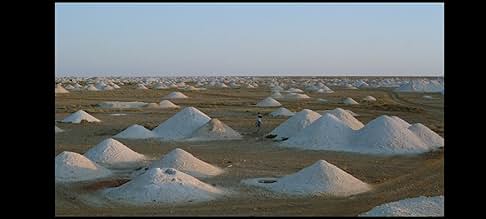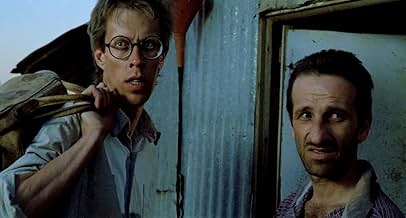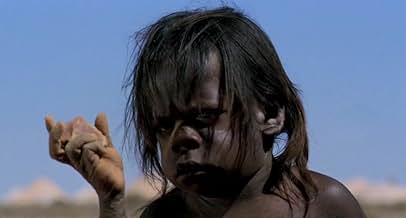Le pays où rêvent les fourmis vertes
Titre original : Wo die grünen Ameisen träumen
- 1984
- Tous publics
- 1h 40min
NOTE IMDb
6,9/10
2,8 k
MA NOTE
Un géologue employé par une société minière australienne se retrouve à contester les droits de certains aborigènes qui croient que leur terre est sacrée.Un géologue employé par une société minière australienne se retrouve à contester les droits de certains aborigènes qui croient que leur terre est sacrée.Un géologue employé par une société minière australienne se retrouve à contester les droits de certains aborigènes qui croient que leur terre est sacrée.
- Réalisation
- Scénario
- Casting principal
- Récompenses
- 2 victoires et 2 nominations au total
Avis à la une
The geologist Lance Hackett is employed by an Australian mining company to map the subsoil of a desert area covered with ant hills prior to a possible uranium extraction. His work is impeded by some aborigines who explain that this is the place where the green ants dream.
Werner Herzog makes great films, and he is quite prolific in what he does. His career sees to be divided between unusual drama and documentaries of different cultures. This film, perhaps more than any other of his work, really blends the two. While not a documentary, it really tries to celebrate aborigine culture.
Of all the films based in Australia, this is one of the better ones. It may not be reality, but it is in some ways better than reality. Herzog creates a world that is completely believable.
Werner Herzog makes great films, and he is quite prolific in what he does. His career sees to be divided between unusual drama and documentaries of different cultures. This film, perhaps more than any other of his work, really blends the two. While not a documentary, it really tries to celebrate aborigine culture.
Of all the films based in Australia, this is one of the better ones. It may not be reality, but it is in some ways better than reality. Herzog creates a world that is completely believable.
I would classify this movie as being Herzog's most mainstream (which I know isn't saying that much), but still, for a movie that takes place in possibly the most minimalist setting (a stretch of land on the Australian outback littered with the remains of drilling for minerals) I found it absolutely engrossing. This is the movie: A group of aborigines refuse to budge from a small strip of land when a mining company wants to occupy it for drilling purposes; their reason: `This is the land where the green ants dream'. When one of the aborigines is asked why they will not budge even after offered a lucrative settlement, he responds, `How would you like it if someone drove a bulldozer over your church.' Immediately I knew this movie would work. It is a very good film, possibly one of the most finely put together movies I can think of. Rather than being an all and out movie that puts down imperialism, civilization, and national need to exploit resources.it raises some interesting questions about ownership and the present destruction of ancient civilizations. My one fault with the movie is that you know when Herzog is setting things up for an awe-inspired moment, and it does get a little dry toward the end, but still a grand achievement.
Herzog is a simple man, easy to read. Hearing him talk of his films, one gets bored easily.
His films are simply conceived, like Lynch's, but once he gets rolling, his intuitions take him to strange, exotic corners of the soul. There he leaves traces that last. I love the man's work, much of it. I love the fact that he really seems to be driven by urges that seem to accidentally result in something that can cross the distribution divide to reach me. This is no small feat; the films I watch that have ideas and matter are what maybe a millionth, a billionth? of the similarly deep insights and artifacts that would have similar effect in me, but which cannot cross that divide.
When I watch his work, some of which I reserve for the future, it is a dip into the film of Herzog. Failures add to this. Risks that did not pan out for him, do for me.
This film has some heavy disadvantages. He is in Australia and he simply does not understand that to photograph the land the way it affects its inhabitants, you have to photograph nothing. Nothing is what matters. But he gives us a tornado. Its beautiful and violent it even fits the story. He gives us unrelenting piles of boring waste. This too is effective in the film, but not of the place.
He misses both the place and he people. He does give us beautiful Aboriginal faces. He does celebrate them. But its from a deeply disturbing patriarchal, colonial perspective. There is some of this in his Peruvian adventures, but it is hidden in his respect for the Jungle. The natives are simply part of the terrain. He cannot do that here. This also suffers in that he felt it necessary to have an on-screen observer who "learns" the value of the place and turns from heading the mining effort to living with the people.
The result is that the film is overt in its sentiments, but everything works against its honesty. We are left with having to accept it locally, each scene as a sort of standalone taste: black patient faces staring out of pilot seats in an airplane given to them; a man on a witness stand testifying in a language no other soul on the planet understands; an old biddy waiting in the sun at a mine opening on the of chance that her beloved doggie will reappear; that tornado; the (overearnest) story of the sleeping green ants whose dreams we are.
This has value in those small pieces, pretty much throughout. But in the large, taken the way he intends it, its just a colonial German peering into a quaint culture as an ordinary tourist would. So it dilutes the greater story, the greater film of the man.
Ted's Evaluation -- 2 of 3: Has some interesting elements.
His films are simply conceived, like Lynch's, but once he gets rolling, his intuitions take him to strange, exotic corners of the soul. There he leaves traces that last. I love the man's work, much of it. I love the fact that he really seems to be driven by urges that seem to accidentally result in something that can cross the distribution divide to reach me. This is no small feat; the films I watch that have ideas and matter are what maybe a millionth, a billionth? of the similarly deep insights and artifacts that would have similar effect in me, but which cannot cross that divide.
When I watch his work, some of which I reserve for the future, it is a dip into the film of Herzog. Failures add to this. Risks that did not pan out for him, do for me.
This film has some heavy disadvantages. He is in Australia and he simply does not understand that to photograph the land the way it affects its inhabitants, you have to photograph nothing. Nothing is what matters. But he gives us a tornado. Its beautiful and violent it even fits the story. He gives us unrelenting piles of boring waste. This too is effective in the film, but not of the place.
He misses both the place and he people. He does give us beautiful Aboriginal faces. He does celebrate them. But its from a deeply disturbing patriarchal, colonial perspective. There is some of this in his Peruvian adventures, but it is hidden in his respect for the Jungle. The natives are simply part of the terrain. He cannot do that here. This also suffers in that he felt it necessary to have an on-screen observer who "learns" the value of the place and turns from heading the mining effort to living with the people.
The result is that the film is overt in its sentiments, but everything works against its honesty. We are left with having to accept it locally, each scene as a sort of standalone taste: black patient faces staring out of pilot seats in an airplane given to them; a man on a witness stand testifying in a language no other soul on the planet understands; an old biddy waiting in the sun at a mine opening on the of chance that her beloved doggie will reappear; that tornado; the (overearnest) story of the sleeping green ants whose dreams we are.
This has value in those small pieces, pretty much throughout. But in the large, taken the way he intends it, its just a colonial German peering into a quaint culture as an ordinary tourist would. So it dilutes the greater story, the greater film of the man.
Ted's Evaluation -- 2 of 3: Has some interesting elements.
I also remember this film as life-changing. I saw it at the TIFF many years ago and was baffled by it.
There is a small scene in an elevator that I remember as a transcendent cinematic moment.
Like so many of Herzog's films, it is deeply moving for reasons that aren't easy to put your finger on - often with Herzog it's an odd juxtaposition, an awkward silence, a strange edit, an inappropriate flash of humour or horror that produce a flash of insight.
This film, at the time, seemed conventional by Herzog's standards, but I still left the theatre feeling slightly drugged, always a good sign.
There is a small scene in an elevator that I remember as a transcendent cinematic moment.
Like so many of Herzog's films, it is deeply moving for reasons that aren't easy to put your finger on - often with Herzog it's an odd juxtaposition, an awkward silence, a strange edit, an inappropriate flash of humour or horror that produce a flash of insight.
This film, at the time, seemed conventional by Herzog's standards, but I still left the theatre feeling slightly drugged, always a good sign.
Where the Green Ants Dream- at the least featuring one of Werner Herzog's best titled films as it's one of those amazing visuals one gets out of the strangest of the director's work- is placed in a somewhat minor cannon of the German maverick's work, and maybe rightfully so. It's about a controversial topic, that of the rights of the Aborigines and the Australian's seeming right via original British Imperial rule, and it features practically all non-professional actors and some shaky transitions between its sturdy plot and non-sequiters and quintessential Herzogian landscapes. If I were recommending Herzog films to a friend this wouldn't be at the top of the crop (unless of course one is fervently into Australian issue movies or love that one song from the 80s "Beds are Burning"). But it's by no means an over-ambitious quagmire like Heart of Glass, and at worst it's occasionally dull or, and I hate to say this for Herzog, too eccentric for its own good.
It's not to say some of Herzog's bits of character eccentricities aren't out of place. There's featured here amid the story of an aboriginal tribe peacefully protesting and standing their ground against construction on a sacred land of the title name various strange bits of business. My favorite was that mid-section involving the Aborigines asking for a plane, assumed on the part of the construction group as part of the negotiations, and features in one of the oddest parts of the movie the one black pilot from the Aussie air force who keeps singing "My baby does the hanky-panky" to himself. And there's some cool visuals of stock tornado footage and those barren wastelands and perplexing dunes and pyramid-hills in the desert plains that provide the director some choice locations to film. It's hard not to see for the Herzog fan some allotment of poetry.
But there are some problems that I couldn't quite ignore. Despite the acting force of Bruce Spence, who displays far more here as a gifted actor (contrary to what another IMDb reviewer said) and as more than just the kooky flier in the Mad Max movies, the acting is in general fairly weak and at best standard and too off-kilter. It's fairly distracting when Herzog can't quite corral his actors as well as with his technical skills; this also despite some real 'presence' with the two aboriginal chiefs. And certain big scenes, like the courtroom, aren't as effective as might have been intended and come off as dry and too naturalistic and stuffy.
And yet, even with these qualms, it's got some real courage and conviction with its message, which is that aside from the typical "respect the native culture" beat is that people need to learn to live together and not have cultures lost and squandered in the face of bigotry and imperialistic attitudes that should have been squashed decades ago. It's a very good, if not great, examination of a meeting of two societies and an identification of "the other" by a filmmaker willing to take it on. 7.5/10
It's not to say some of Herzog's bits of character eccentricities aren't out of place. There's featured here amid the story of an aboriginal tribe peacefully protesting and standing their ground against construction on a sacred land of the title name various strange bits of business. My favorite was that mid-section involving the Aborigines asking for a plane, assumed on the part of the construction group as part of the negotiations, and features in one of the oddest parts of the movie the one black pilot from the Aussie air force who keeps singing "My baby does the hanky-panky" to himself. And there's some cool visuals of stock tornado footage and those barren wastelands and perplexing dunes and pyramid-hills in the desert plains that provide the director some choice locations to film. It's hard not to see for the Herzog fan some allotment of poetry.
But there are some problems that I couldn't quite ignore. Despite the acting force of Bruce Spence, who displays far more here as a gifted actor (contrary to what another IMDb reviewer said) and as more than just the kooky flier in the Mad Max movies, the acting is in general fairly weak and at best standard and too off-kilter. It's fairly distracting when Herzog can't quite corral his actors as well as with his technical skills; this also despite some real 'presence' with the two aboriginal chiefs. And certain big scenes, like the courtroom, aren't as effective as might have been intended and come off as dry and too naturalistic and stuffy.
And yet, even with these qualms, it's got some real courage and conviction with its message, which is that aside from the typical "respect the native culture" beat is that people need to learn to live together and not have cultures lost and squandered in the face of bigotry and imperialistic attitudes that should have been squashed decades ago. It's a very good, if not great, examination of a meeting of two societies and an identification of "the other" by a filmmaker willing to take it on. 7.5/10
Le saviez-vous
- AnecdotesThe whole story of the green ants was made up by Werner Herzog, it's not a part of genuine Aboriginal folklore. However the courtroom incident where a secret artifact is revealed, to the bemusement of the judge, is based on a real incident.
- Citations
Lance Hackett: The situation, your Honor, is this man is the the sacred custodian to the secrets of this tribe. And his tribe has died out. He is the sole and final survivor of his people, his clan. They call him the mute, because there is nobody left on this earth for him to speak with.
- Bandes originalesRequiem Op. 48
Music by Gabriel Fauré
Meilleurs choix
Connectez-vous pour évaluer et suivre la liste de favoris afin de recevoir des recommandations personnalisées
- How long is Where the Green Ants Dream?Alimenté par Alexa
Détails
- Date de sortie
- Pays d’origine
- Langue
- Aussi connu sous le nom de
- Where the Green Ants Dream
- Lieux de tournage
- Sociétés de production
- Voir plus de crédits d'entreprise sur IMDbPro
- Durée
- 1h 40min(100 min)
- Mixage
- Rapport de forme
- 1.85 : 1
Contribuer à cette page
Suggérer une modification ou ajouter du contenu manquant






























